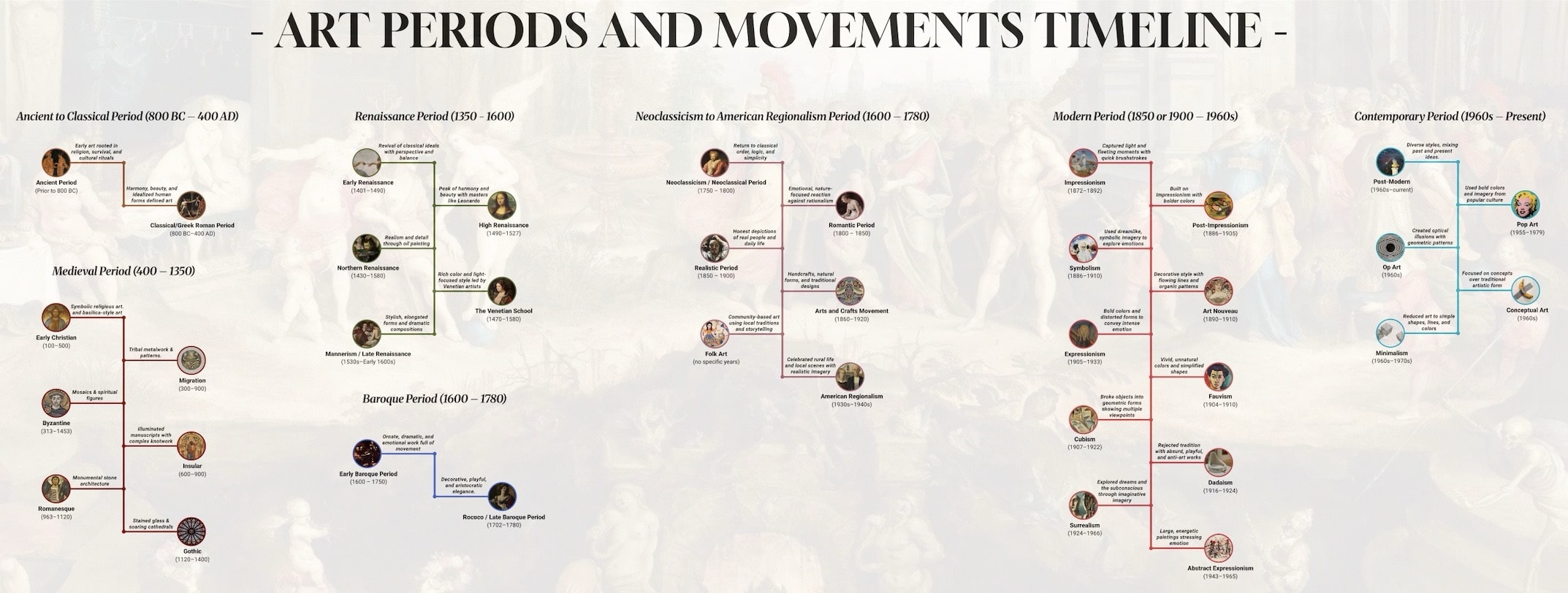Art has been part of human life since prehistoric times, starting with simple carvings on stone. Over the centuries, it evolved, with each period bringing its own style and focus. Romanticism celebrated nature, Baroque highlighted grandeur, and every movement reflected the society of its time.
Understanding major art movements is valuable for students, collectors, or anyone who appreciates art. This timeline guides you through the key periods, showing how art has changed and how it continues to inspire creativity today.
In this article
Art Periods and Movements Timeline
Art has been part of human life for over 40,000 years. Early cave paintings in France and Spain show animals and hunting scenes. Ancient Egyptian art from 3,000 BC focused on gods and the afterlife, reflecting the beliefs and daily life of people. Each period tells a story about society, culture, and creativity.
This timeline continues that story, guiding you through major periods of art. From Medieval and Classical to Romantic and Modern, each era introduced new styles, techniques, and ideas. Together, they show how art evolved over centuries. Let’s get started.
Ancient Period (prior to 800 BC)
Art existed long before organized societies or written language. Early humans carved stone, painted on cave walls, and created sculptures. These works often represented animals, supernatural beings, and everyday life. Art was used in rituals, as a tool for survival, and to communicate stories. These simple creations provide insight into early human life and thinking.
The Lascaux caves in France display walls full of painted animals. Using natural pigments, early humans created detailed images that emphasized the importance of hunting and spiritual traditions. Art allowed them to express ideas and connect with their environment in meaningful ways.
Classical Greek/Roman Period (800 BC - 400 AD)
During this time, art started to celebrate people, beauty, and order. The Greeks were obsessed with balance and harmony. Sculptors carved perfect human bodies in marble. Artists wanted their creations to look ideal, not just realistic.
Romans borrowed heavily from the Greeks. They added architecture, mosaics, and portraits of leaders. Art told stories of gods, heroes, and emperors. It was not just decoration, it showed power, culture, and pride. Public buildings, temples, and forums became canvases for creativity. People started to see art as a way to inspire and communicate ideas.
Medieval Period (400 - 1350 AD)
After the fall of the Roman Empire, Europe entered the Medieval period. It is sometimes called the Dark Ages, but it was also a time of rich spiritual creativity. Art focused on religion and symbolism. Most works were created to honor God or teach biblical stories.
Medieval religious art appeared in many forms, including paintings, tapestries, mosaics, and manuscripts. This period is divided into several distinct phases, each with its own style and focus:
- Early Christian (100-500 AD): Artists blended Roman techniques with religious themes. Churches and catacombs were decorated with mosaics and frescoes. The goal wasn’t realism. Instead, the focus was on symbols and spiritual messages. Each artwork guided people in their faith.
- Migration art (300-900 AD): After Rome’s collapse, Germanic tribes moved across Europe. Their art reflected tribal identity. Jewelry, weapons, and tools became beautifully decorated. Patterns were intricate, showing skill and cultural pride. Survival and symbolism were still key themes.
- Byzantine (313-1453 AD): In the Byzantine Empire, the Church was central to life. Art was highly stylized and symbolic. Golden mosaics, domes, and religious icons dominated. Faces were often emotionless, focusing on spiritual authority rather than realistic expression. Every piece reminded people of divine power.
- Insular art (600-900 AD): Also called Celtic art, Insular art was intricate and detailed. Artists loved geometric shapes, interlacing patterns, and abstract designs. Manuscripts like the Book of Kells showed tiny illustrations with incredible detail. Art was basically a reflection of skill and devotion.
- Romanesque (963-1120 AD): Romanesque art brought optimism after centuries of hardship. Churches had thick walls, rounded arches, and decorative sculptures. The focus was still religious, but stories from the Bible were told in stone, frescoes, and carvings. Art became more structured and monumental.
- Gothic (1120-1400 AD): Gothic art reached new heights, literally. Cathedrals soared with pointed arches and tall spires. Stained glass windows filled interiors with color and light. Sculptures and paintings combined to inspire awe. Art was about guiding people to think of heaven and the divine.
Renaissance Period (1350 - 1600)
The Renaissance was a rebirth of classical ideas and creativity. Artists began to focus on realism, perspective, and human emotion. Paintings and sculptures celebrated people, nature, and knowledge, not just religion.
It was a time of exploration and discovery. Artists experimented with techniques to make their work more lifelike. This period set the stage for some of the most famous masterpieces, inspiring creativity for centuries to come. Renaissance classic and realistic ideas were further extended into the following movements.
- Early renaissance (1401-1490): The Early Renaissance started in Italy. Artists focused on realistic human forms and natural landscapes. They experimented with perspective to make scenes look three-dimensional. Paintings showed everyday life alongside religious themes. This period set the stage for some of the most famous art ever created.
- High renaissance (1490-1527): The High Renaissance gave us legends like Leonardo da Vinci, Raphael, and Michelangelo. Their art was balanced, detailed, and expressive. Human anatomy, emotion, and light all came to life on canvas and in sculpture. The example of the Mona Lisa or the Sistine Chapel ceiling masterpieces combined skill with imagination.
- Northern renaissance (1430-1580): While Italy led in perspective and human anatomy, the North focused on smaller details. Artists like Jan Van Eyck painted everyday life with incredible precision. Their work often reflected Protestant values and was more humble than Italian grandeur.
- Venetian school (1470-1580): Venetian artists loved color. They created vibrant paintings with dramatic lighting to evoke joy and emotion. The focus was less on strict realism and more on the beauty of the moment.
- Mannerism /late renaissance (1530s - early 1600s): Late Renaissance artists, inspired by Michelangelo and Raphael, experimented with imagination. Figures became elongated and stylized. Colors were bold and unusual. The focus shifted from realism to emotion and creativity, showing the artist’s personal vision.
Baroque Period (1600 - 1750)
Baroque art was dramatic, emotional, and grand. Artists used contrast, rich colors, and movement to draw viewers into the scene. Paintings, sculptures, and architecture were all meant to impress and inspire awe.
The Church and rulers commissioned Baroque art to show power and devotion. Artists like Rubens, Rembrandt, and Bernini mastered the style, combining theatrical effects with technical skill. Each work told a story with drama and intensity.
- Rococo/late baroque (1702-1780): Rococo was a lighter, more playful version of Baroque. It focused on decoration, elegance, and the lives of the aristocracy. Soft pastel colors, delicate brushwork, and graceful scenes of leisure became popular in France. Unlike Baroque, Rococo celebrated charm and beauty rather than drama.
Neoclassicism / Neoclassical Period (1750 - 1800)
Neoclassical art went back to the clean, simple style of ancient Greece and Rome. Artists focused on balance, harmony, and clear, calm compositions.
It was a reaction against the fancy, playful styles of Baroque and Rococo. Neoclassical works looked more serious and orderly. Paintings and sculptures showed ideal beauty, told moral stories, and celebrated reason and logic instead of strong emotions.
Romantic Period (1800 - 1850)
Romanticism rejected rationality and celebrated emotion, imagination, and nature. Artists painted dramatic landscapes, heroic scenes, and intense feelings to stir the viewer’s soul.
They loved the wild, untamed beauty of nature. Painters like Caspar David Friedrich captured misty mountains and stormy skies. Romantic art expressed freedom, passion, and individuality. It was a celebration of emotion over reason.
Realistic Period (1850 - 1900/1940s)
Realism focused on life as it really was. Artists painted ordinary people and daily life without romanticizing it. Gustave Courbet, for example, painted farmers and workers exactly as they appeared.
It rejected exaggeration and fantasy. Photography and journalism influenced Realist painters like Gustave Courbet, who portrayed farmers, workers, and the struggles of daily life with accuracy and integrity.
- Arts and crafts movement (1860-1920): The Arts and Crafts movement reacted against industrialization. Artists wanted handcrafted, beautiful objects for homes and everyday life. It included everything from furniture to textiles, combining skill and practicality.
- Folk art (no specific dates): Folk art comes from ordinary people rather than trained artists. It reflects culture, tradition, and daily life. Often colorful and expressive, it gives us insight into communities and local stories.
- American regionalism (1930s-1940s): Emerging during the Great Depression, American Regionalism celebrated rural life in the South and Midwest. Artists like Grant Wood showed hardworking farmers and local towns. The style was realistic and patriotic, reflecting pride in everyday America.
Modern Period (1850 or 1900 - 1960s)
The Modern Period was about breaking old rules and experimenting with new ideas. Artists explored new techniques, materials, and ways of seeing the world. This era challenged traditions and introduced movements that questioned reality and perspective.
Modern art focuses on individual expression. Artists experimented with abstraction, color, and form. Everyday life, emotions, and social issues became key subjects. Creativity became more personal, reflecting the rapidly changing modern society.
- Impressionism (1872-1892): Impressionism was an art movement that focused on capturing the essence of the moment. Artists painted quickly to show light, color, and atmosphere. The artworks had visible brushstrokes, vibrant colors, and lively scenes from everyday life and nature.
- Post-Impressionism (1886-1905): Post-Impressionism was a reaction to Impressionism. Unlike the previous movement, it focused on structure, form, and personal expression. Artists explored emotions, symbolism, and abstract ideas to engage the mind and soul.
- Symbolism (1886-1910): Symbolism art was about expressing ideas and emotions beyond reality. Themes were often mystical, dreamlike, or dark. The artworks explored imagination, fear, and desire, influencing literature and later modern art movements.
- Art nouveau (1890-1910): Art Nouveau followed the Japanese Arts and Crafts movement. It focused on nature, flowing lines, and decorative elements. In the U.S., it was also called the Tiffany style. The style appeared in architecture, painting, and design.
- Expressionism (1905-1933): Expressionism, as the name suggests, was about expressing emotions through distorted reality. Artists distorted forms and colors to show feelings. The artworks aimed to move viewers emotionally rather than depict reality accurately.
- Fauvism (1904-1910): Fauvism, meaning “wild beasts,” emphasized bold, unnatural colors. Artists exaggerated shapes and colors to create energetic, emotional works. Fauvism encouraged freedom and experimentation in painting. 极
- Cubism (1907-1922): Cubism encompassed abstract art. Artists broke objects into geometric shapes and showed multiple perspectives at once. Pablo Picasso and Braque were leading figures of the movement.
- Dadaism (1916-1924): Dadaism focused on creating art that was ironic and provocative. It challenged traditional art and questioned society, capitalism, and war. The movement emerged as a response to World War I.
- Surrealism (1924-1966): Surrealism drew inspiration from Dada. Artists created illogical and dreamlike scenes. They believed the unconscious mind was free from reason and moral limits.
- Abstract expressionism (1943-1965): Abstract Expressionism focused on emotion and the subconscious. Artists like Jackson Pollock created energetic, non-representational works. The movement reflected freedom, anxiety, and the complexities of modern life.
Contemporary Period (1960s - current)
Contemporary, or postmodern, art is the current and ongoing period in art history. Artists today often disagree on a single definition of what art truly is. Contemporary art is diverse, experimental, and focused on ideas rather than traditional aesthetics.
It includes many movements and styles, influenced by technology, politics, and pop culture. Artists use any medium to create their work and often challenge viewers to question what art is and what it can mean.
Although definitions vary, contemporary art includes several notable movements.
- Post-modern (1960s - current): Post-Modern art reacts against Modernism. It is skeptical and playful, often critiquing society and culture. Artists mix styles, media, and concepts. Post-Modern works can be ironic, provocative, and challenging, questioning traditional art definitions.
- Pop art (1955-1979): Pop Art celebrated everyday objects and mass media. Artists like Andy Warhol and Roy Lichtenstein used bright colors and commercial imagery. It blurred the line between high art and popular culture. Pop Art made art accessible and fun, reflecting society’s consumerism.
- Op art (1960s): Op Art explored optical illusions. Artists used shapes, lines, and patterns to create movement and depth. The style played with human perception. It was influenced by science and technology, creating artworks that seem to move or vibrate before your eyes.
- Conceptual art (1960s): Conceptual Art focuses on ideas over aesthetics. The concept matters more than the physical artwork. Artists challenge traditional notions of skill, beauty, or value. Performance, installations, and written instructions can be considered art in this movement.
- Minimalism (极1960s-1970s): Minimalism emphasized simplicity and the material of the artwork. Artists removed unnecessary details to focus on essence. The movement often used geometric shapes, limited colors, and repetition. Minimalist art invites viewers to experience the work’s form and space directly.
How to Create a Similar Timeline Using EdrawMax?
Art has evolved over thousands of years, and it's difficult to track all the movements, styles, and milestones. EdrawMax, a helpful timeline creator, makes it easy. With its templates and tools, you can create a professional and visually appealing art periods timeline in minutes.
Follow these steps to make your art periods timeline:
Step1Start with a Blank Canvas
- Open EdrawMax on your desktop and log in, or register if you’re a new user.
- Click New on the left panel, then choose Blank Drawing to open a fresh canvas for your Art Periods Timeline.
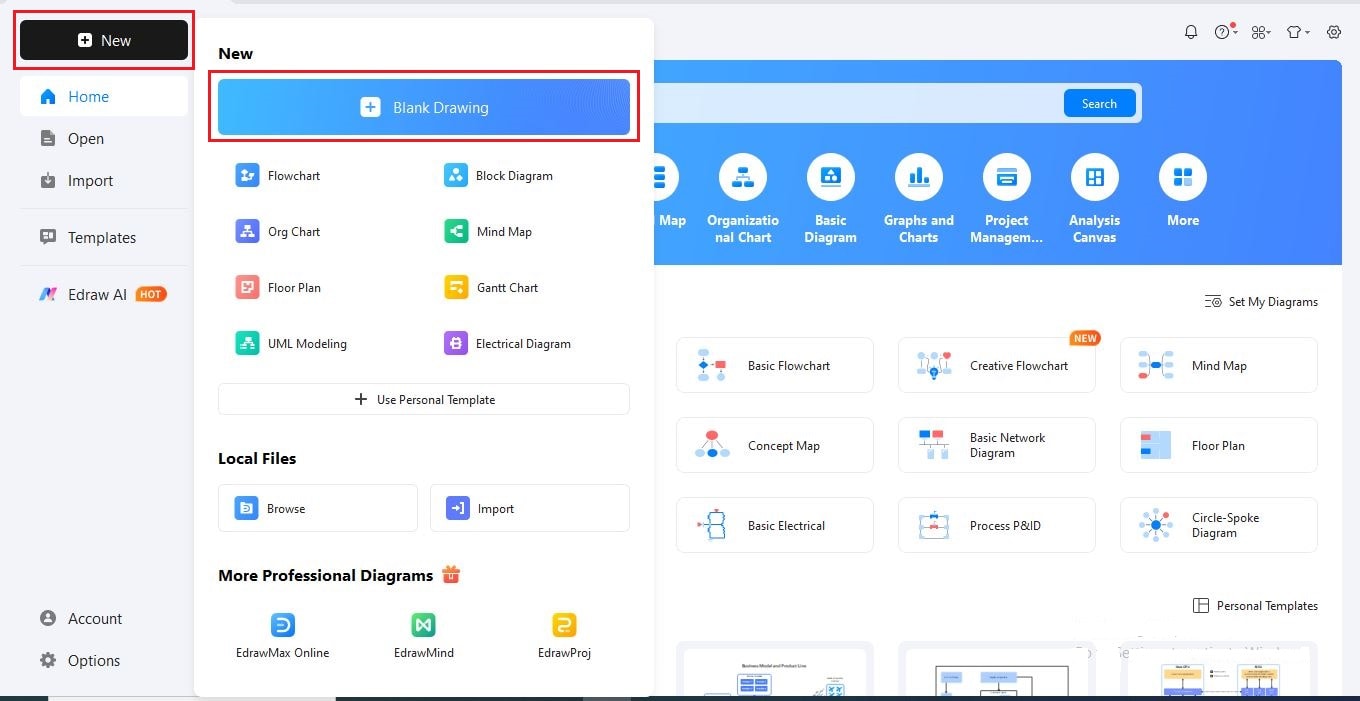
Step2Add a Background Image
- Go to the Insert tab and click Picture.
- Choose Local Pictures to upload a background image that fits your timeline.
- Use the Adjust option on the floating toolbar to change brightness, contrast, or transparency so it matches well with your design.
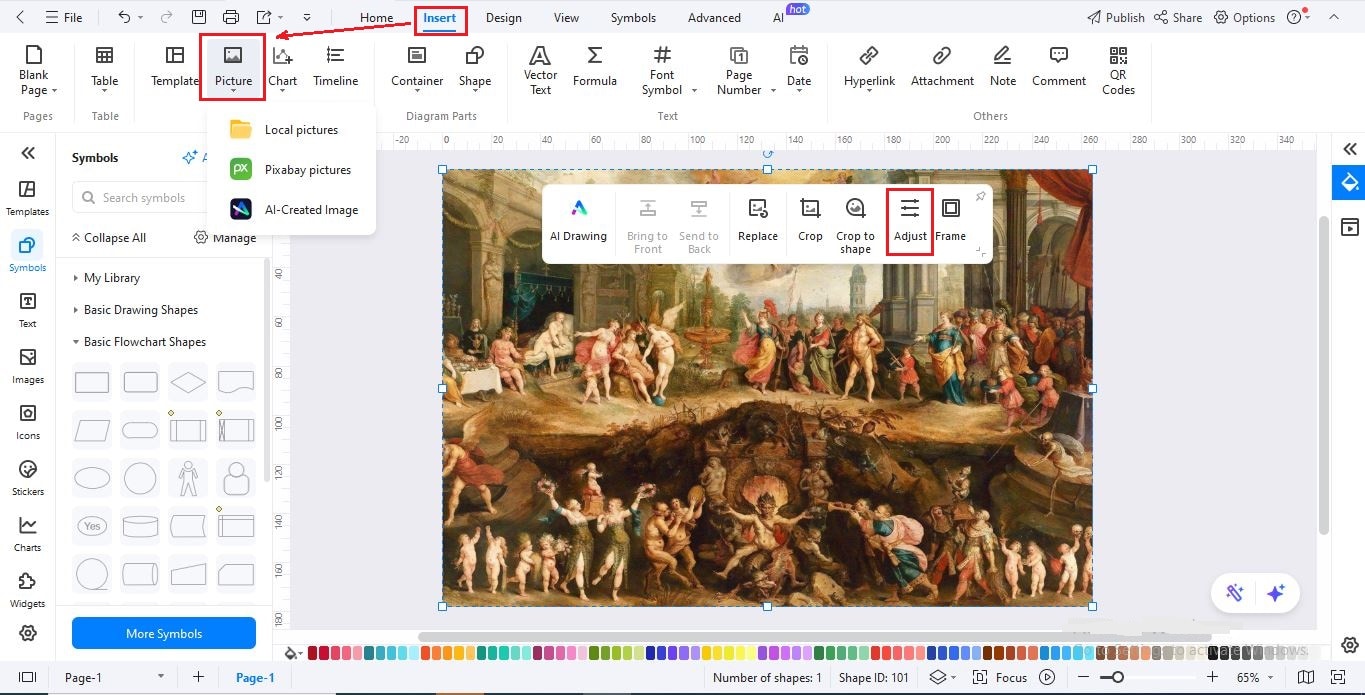
Step3Insert a Timeline Title
- Add a title such as “Art Periods and Movements Timeline” using text or image. We'll use text here.
- Click Text and then Click to Add Title极 to add your heading.
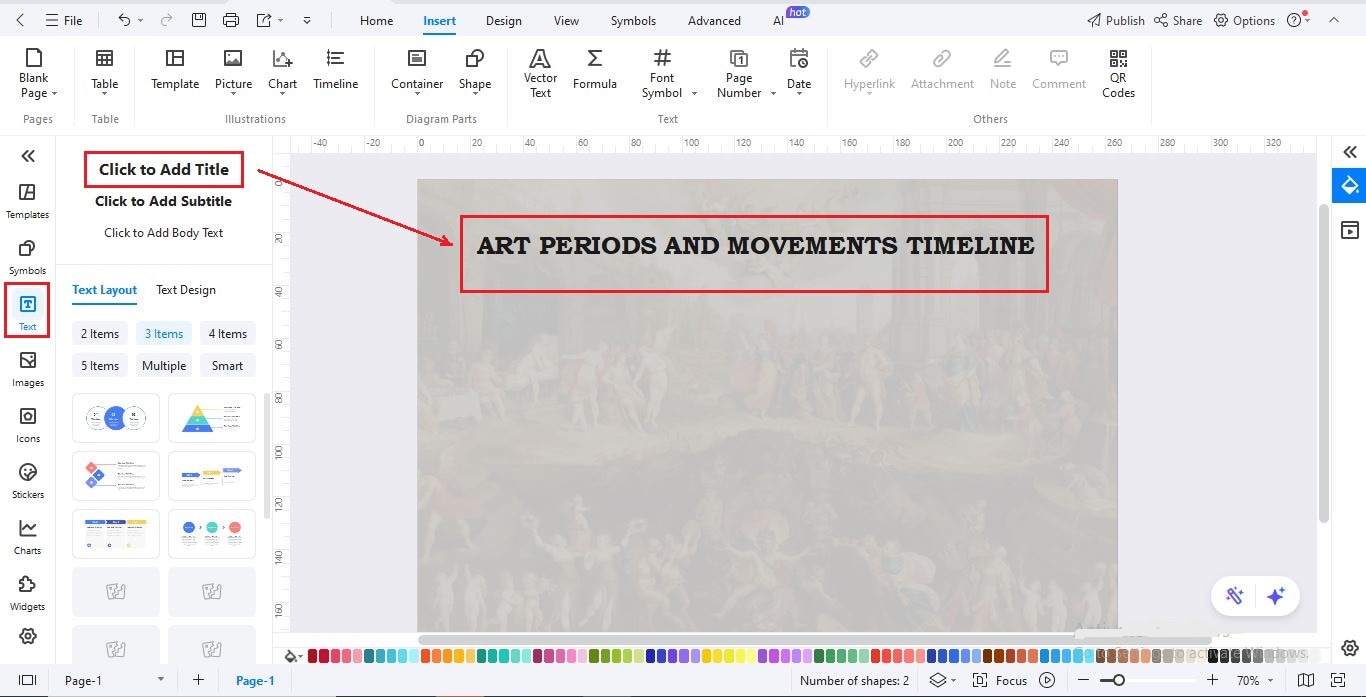
Step4Insert the Timeline Layout
- On the top menu, go to Insert and select Timeline.
- Pick a Vertical Timeline with image placeholders, then click OK to add it to your canvas.
- Click on the timeline to open a toolbar where you can adjust its structure to fit different art periods and movements.
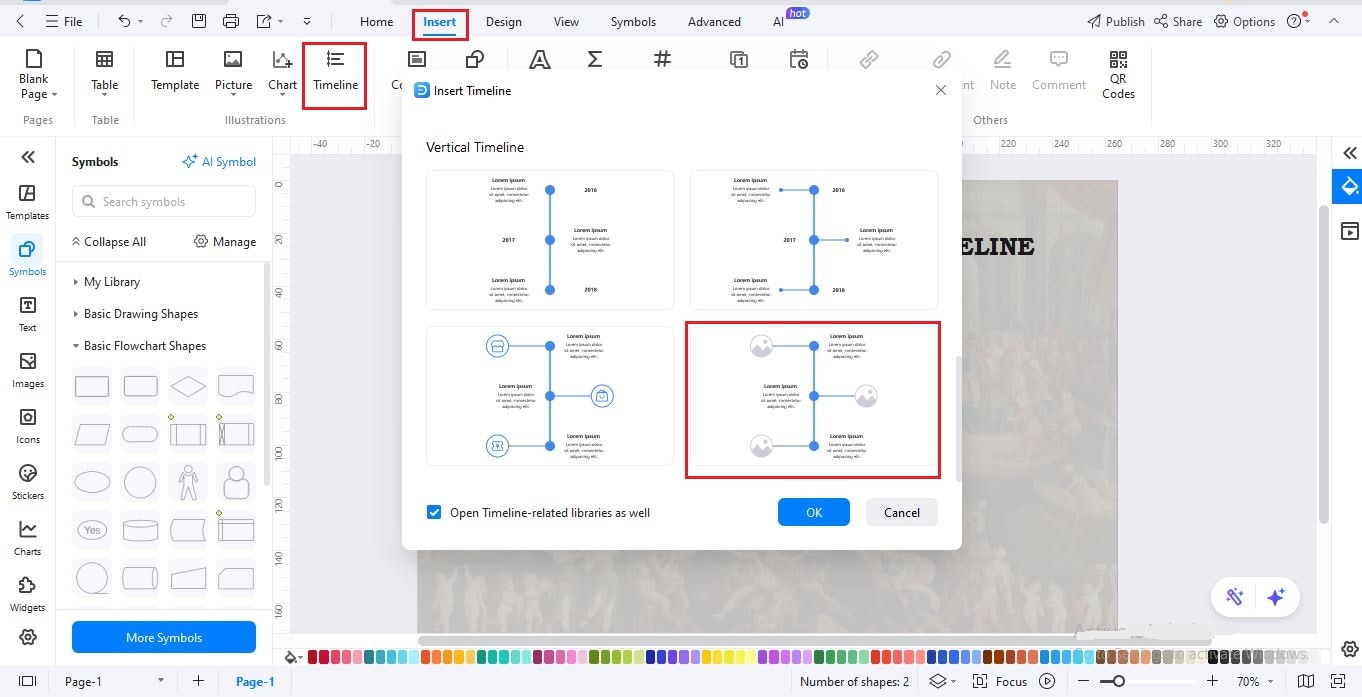
Step5Add Key Art Periods
- Click Text on the left editing panel.
- Use Click to Add Subtitle for each art period.
- Then use Click to Add Body to add short descriptions of each period’s characteristics, famous artists, and notable works.
- Continue until all major art periods are mapped.
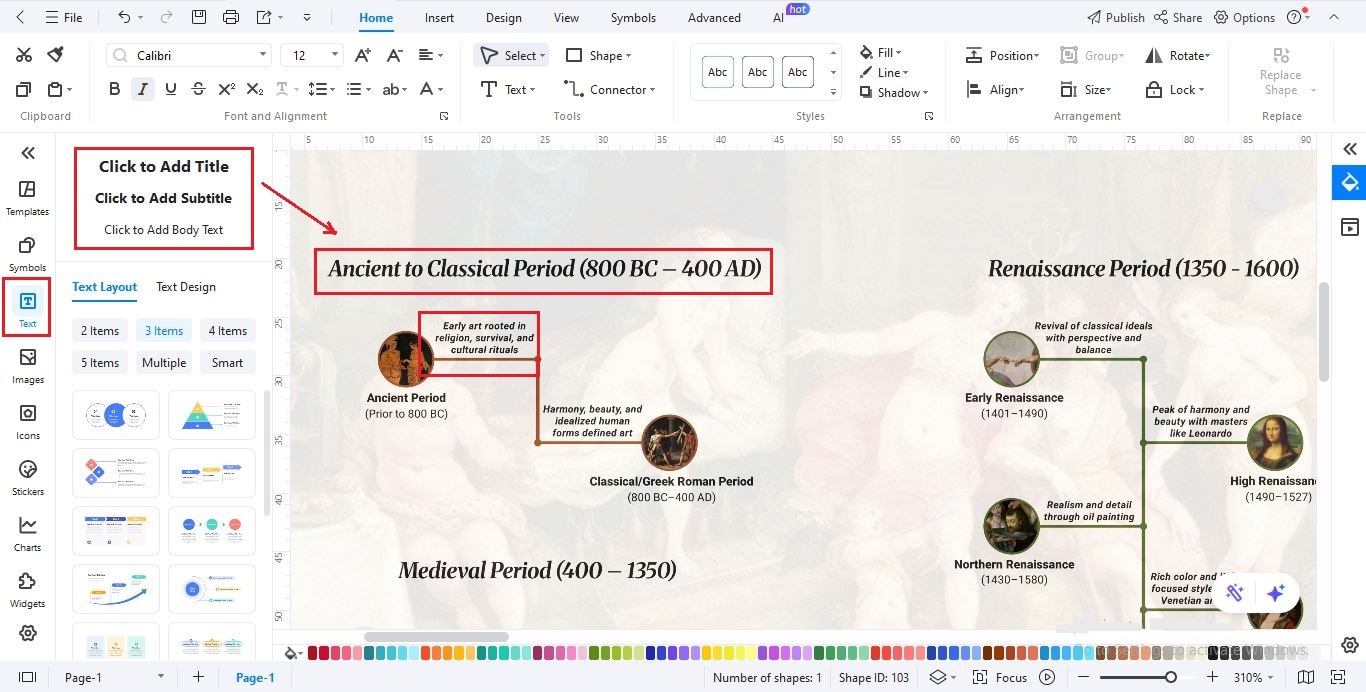
Step6Insert Thumbnail Images
- Go to Insert > Picture > Local Pictures and upload images for each art period, such as famous paintings, sculptures, or artistic tools.
- Click an image, choose Crop to Shape, and select a frame style to match your layout.
- Repeat for each key milestone.
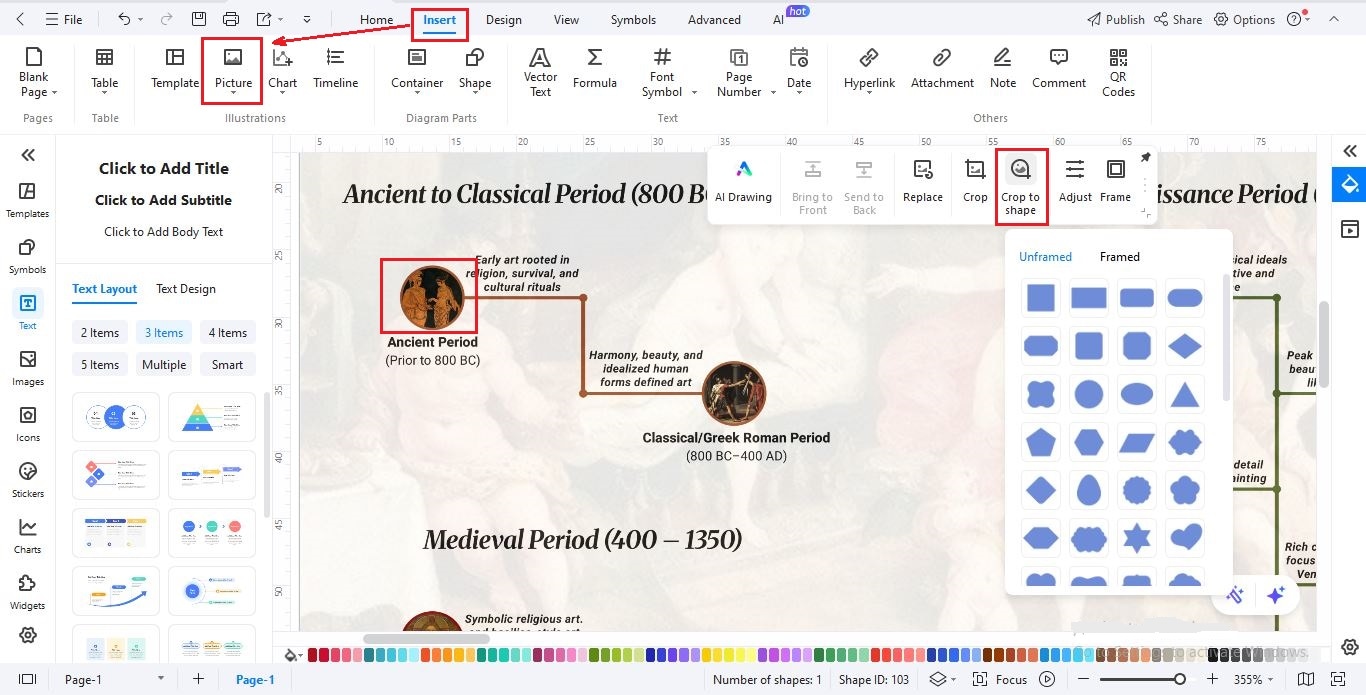
Step7Save and Share Your Timeline
- When your timeline is complete, click File > Save to keep an editable version.
- To share it, go to File > Export and choose formats like PNG, PDF, SVG, HTML, Visio, or Excel.
- To inspire others, click Publish to share your timeline with the EdrawMax community.
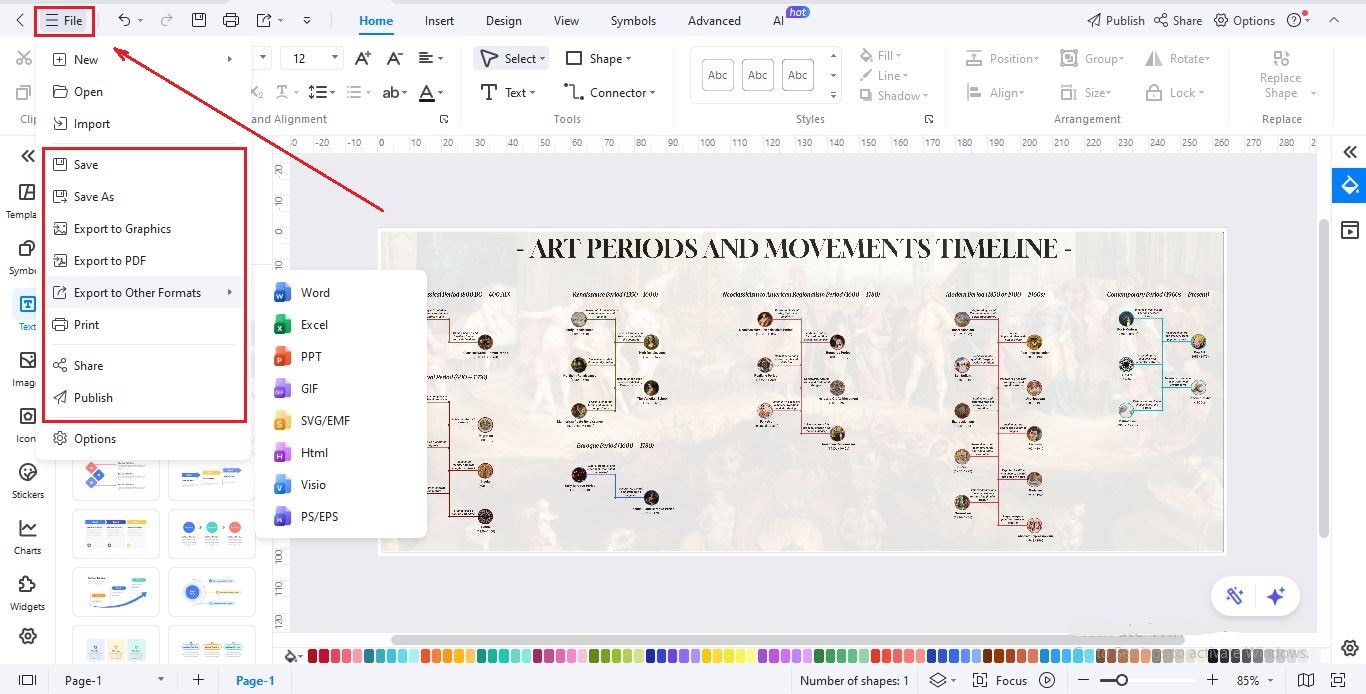
Closing Remarks
Art periods and movements show how humans expressed ideas, emotions, and culture. Each period added new techniques and styles while reflecting society and daily life. Artists built on earlier work, creating a chain of creativity across centuries. Studying these movements shows how art evolved and how history influenced human expression through ages.
If you want to create a similar timeline, EdrawMax can help. Its ready-made templates and simple tools let beginners create professional timelines in minutes.




